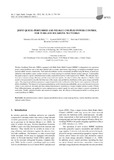| dc.contributor.author | Wyk, Barend Jacobus Van | |
| dc.contributor.author | Kogeda, Okuthe P | |
| dc.contributor.author | Djouani, Karim | |
| dc.contributor.author | Olwal, Thomas Otieno | |
| dc.date.accessioned | 2014-02-21T07:35:53Z | |
| dc.date.available | 2014-02-21T07:35:53Z | |
| dc.date.issued | 2012 | |
| dc.identifier.citation | International Journal of Applied Mathematics and Computer Science. Volume 22, Issue 3, Pages 749–764, ISSN (Online) , ISSN (Print) 1641-876X, DOI: 10.2478/v10006-012-0056-z, September 2012 | en_US |
| dc.identifier.uri | http://www.degruyter.com/view/j/amcs.2012.22.issue-3/v10006-012-0056-z/v10006-012-0056-z.xml | |
| dc.identifier.uri | http://hdl.handle.net/11295/64783 | |
| dc.description.abstract | Wireless Backbone Networks (WBNs) equipped with Multi-Radio Multi-Channel (MRMC) configurations do experience power control problems such as the inter-channel and co-channel interference, high energy consumption at multiple queues and unscalable network connectivity. Such network problems can be conveniently modelled using the theory of queue perturbation in the multiple queue systems and also as a weak coupling in a multiple channel wireless network. Consequently, this paper proposes a queue perturbation and weakly coupled based power control approach forWBNs. The ultimate objectives are to increase energy efficiency and the overall network capacity. In order to achieve this objective, a Markov chain model is first presented to describe the behaviour of the steady state probability distribution of the queue energy and buffer states. The singular perturbation parameter is approximated from the coefficients of the Taylor series expansion of the probability distribution. The impact of such queue perturbations on the transmission probability, given some transmission power values, is also analysed. Secondly, the inter-channel interference is modelled as a weakly coupled wireless system. Thirdly, Nash differential games are applied to derive optimal power control signals for each user subject to power constraints at each node. Finally, analytical models and numerical examples show the efficacy of the proposed model in solving power control problems in WBNs. | en_US |
| dc.language.iso | en | en_US |
| dc.subject | optimal control theory | en_US |
| dc.subject | wireless backbone networks | en_US |
| dc.subject | weak coupling theory | en_US |
| dc.subject | singular perturbation theory | en_US |
| dc.subject | decentralized power control | en_US |
| dc.title | Joint queue-perturbed and weakly coupled power control for wireless backbone networks | en_US |
| dc.type | Article | en_US |

